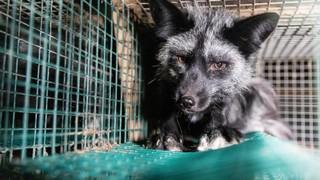
the truth about fur
Even a fur trim comes from extreme cruelty to animals
Whether a fur pom-pom, fur collar or fur trimming on jackets and scarves, each tiniest piece of trim is directly connected to cruelty to animals. A finish made of real fur cannot be relativised by the amount of fur used. From the perspective of animal welfare, there is no 'ethically correct' fur. The fashion industry has been serving us this and many other lies for years in order to rehabilitate the use of fur.
In fact, over 100 million animals die annually for fashion furs.
- Ninety-five percent of furs traded worldwide originates from fur farms mainly in China and Europe where mink, racoon dogs, foxes and other animals are kept in tiny wire cages. The animals are unable to act out their natural behaviour. This monotonous life leads to permanent stress, severe behavioural disorders and self-mutilation. After a few months, the young animals on fur farms are killed in the so-called 'fur harvest'. They suffer an agonising death by gassing, electrocution or lethal injection.
- Trapping, too, is extremely brutal. In North America especially, coyotes, foxes and red lynx are caught using spring traps, snares and body-gripping traps. They are often not killed immediately and may be left in agony for days.
Fur products are always based on animal suffering. Luckily, an increasing number of fashion chains rely on faux fur.
No legal protection for fur animals
In the EU there are no directives or detailed regulations on keeping fur-bearing animals. In 1999, the Council of Europe adopted a recommendation on fur farming. However, it is totally inadequate from the perspective of animal welfare because it continues to permit the confinement of fur animals in tiny cages. Wire-mesh floors and a lack of areas for climbing, digging and bathing are tolerated. Many EU states have no additional regulations on fur farming. Fortunately, more and more countries choose to protect fur animals through stricter national legislation or by completely banning fur farms. But on a global level, most fur animals are either insufficiently protected or not protected at all. China, the world’s principal producer of fur, also has no enforceable law that would protect animals on fur farms.
Place your cursor or finger over the image, click/tap, and erase the top image to reveal the truth.




Animal welfare needs cannot be met on fur farms
The 2023 published report The Case Against Fur Factory Farming: a scientific review of animal welfare standards and ‘WelFur’ reveals the extent of animal welfare failings inherent on fur farms and highlights that the current regulatory framework for the protection of fur animal welfare in the European Union is inadequate. It also finds that the fur industry’s WelFur scheme is not able to address the major welfare issues for mink, foxes and racoon dogs farmed for fur and establishes that enrichment of existing housing systems is unable to address the welfare problems inherent in the cage systems used by the fur industry.
Trapping of wild animals
Trapping, too, is extremely brutal. In North America especially, coyotes, foxes and red lynx are caught using spring traps, snares and body-gripping traps. However, whatever animal first activates a trigger is trapped. Hence, trapping injures or kills countless dogs, cats, deer, and other animals. Trapped animals are often not killed immediately and may be left in agony for days.
Fur products are always based on animal suffering. Luckily, an increasing number of fashion chains go fur-free.
our demands...
- Fashion companies stop selling of fur products!
- Statutory bans on fur farming, as well as an associated import and trade ban on fur and fur products!
- Until a sales ban on fur is achieved: clear labelling of fur products regarding species, production method and origin so consumers can choose to object to animal cruelty in their clothing.



